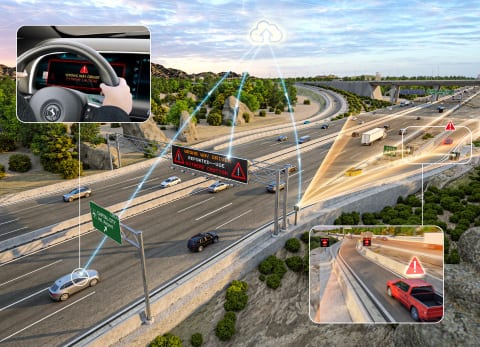Continental announced its Smart City Mobility and Transportation Hub in Auburn Hills, Michigan, the firm said in a release.
The company highlighted that the center of this Smart City Mobility and Transportation Hub are two intersections made intelligent with Continental sensors and intelligent software integrated into the infrastructure.
Ultimately, Continental said, this technology will have the potential to improve traffic flow, reduce pollution and increase the intersection’s safety by communicating hidden dangers to approaching connected vehicles and pedestrians.
“With about 80% of Americans living in urban areas, a steady increase in pedestrian fatalities, and more than 43% of crashes taking place at intersections, a focus on improved safety at city intersections has never been more important,” said Jeremy McClain, director of chassis and safety systems and technology for Continental, North America. “By bringing together a variety of automotive-grade technologies, systems and expertise, Continental’s Smart City technologies have the potential to greatly improve the lives of everyone who enters the area.”
In its current phase, the Smart City Mobility and Transportation Hub is collecting important non-personally identifiable information, like location and movement patterns, about pedestrians, vehicles and other intersection-related activity to create an environment model needed for infrastructure-to-everything (I2X) communication. The environment model provides information about traffic participants, traffic infrastructure, static objects and the overall road situation to connected vehicles.
“With Continental’s sensor technology, we want to apply our years of experience in the automotive industry to make intersections more intelligent, and therefore safer and more efficient,” said Laurent Fabre, head of the passive safety and sensorics business unit at Continental.
The Smart City Mobility and Transportation Hub infrastructure is equipped with Continental’s short and long-range radars. These radar sensors have been deployed on a number of vehicle platforms over the years, and enable functions like adaptive cruise control, blind spot detection, forward collision warning, lane change assist and more.
In addition to the Continental radar sensors, the Auburn Hills Smart City Mobility and Transportation Hub also has a roadside unit and electronic control unit to process data and run the environment model and functions.
This combination can offer a number of benefits, like counting the number of vehicles entering and exiting a specific zone to communicate the number of available parking spaces to interested vehicles. By connecting to a traffic light controller, traffic flow can be better optimized, reducing not only congestion, but also emissions from idling vehicles. The solution makes it possible to warn an approaching vehicle about occluded hazards such as pedestrians. With additional analysis and artificial intelligence, intention prediction of pedestrians becomes possible, helping to alert drivers to pedestrians planning to cross even when the vehicle has the right of way.
Continental also installed its Wrong-Way Driver (WWD) detection system, which warns at-risk drivers in the vicinity of a driver heading the wrong way. Continental’s WWD detection system will be showcased at CES 2020.
The detection technology uses a combination of Continental sensors, connected-vehicle systems and a heatmapping algorithm. The self-learning system automatically defines the roadways and directions of travel, then sends an alert via push notification to a mobile device or connected vehicle informing at-risk vehicles of the wrong-way driver’s location, speed and direction of travel.
In addition to Auburn Hills, Continental operates a Smart City Mobility and Transportation Hub in Changsha, China, as well as Intelligent Intersections in Walnut Creek, California, and Columbus, Ohio, and plans to expand to other cities in the near future.

